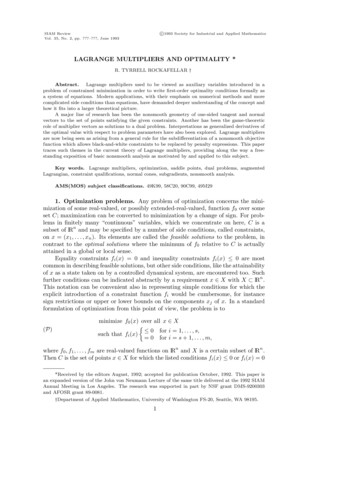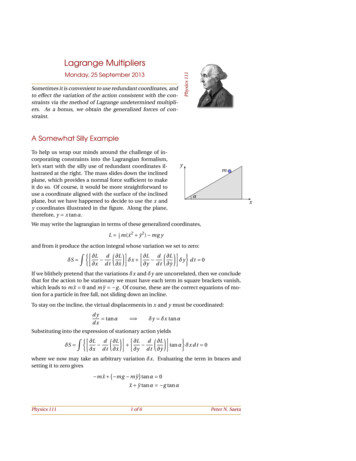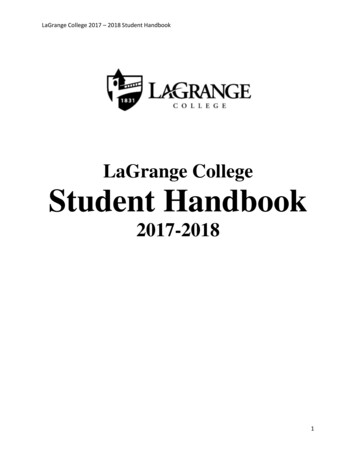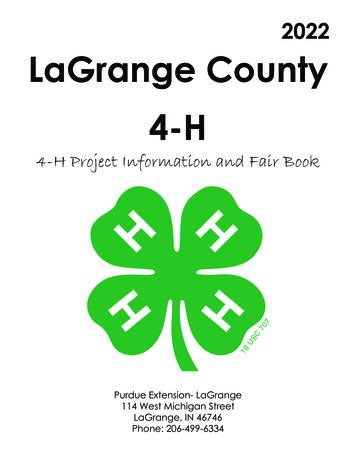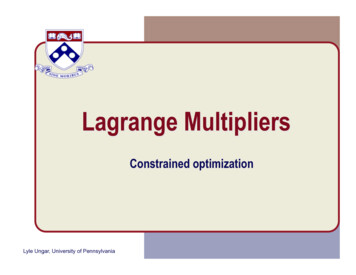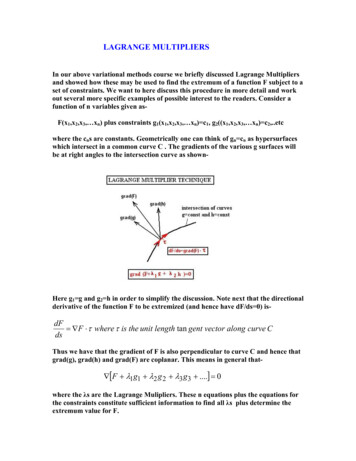
Transcription
LAGRANGE MULTIPLIERSIn our above variational methods course we briefly discussed Lagrange Multipliersand showed how these may be used to find the extremum of a function F subject to aset of constraints. We want to here discuss this procedure in more detail and workout several more specific examples of possible interest to the readers. Consider afunction of n variables given asF(x1,x2,x3, xn) plus constraints g1(x1,x2,x3, xn) c1, g2((x1,x2,x3, xn) c2,.etcwhere the cns are constants. Geometrically one can think of gn cn as hypersurfaceswhich intersect in a common curve C . The gradients of the various g surfaces willbe at right angles to the intersection curve as shown-Here g1 g and g2 h in order to simplify the discussion. Note next that the directionalderivative of the function F to be extremized (and hence have dF/ds 0) is-dF F τ where τ is the unit length tan gent vector along curve CdsThus we have that the gradient of F is also perpendicular to curve C and hence thatgrad(g), grad(h) and grad(F) are coplanar. This means in general that- [F λ1 g1 λ2 g 2 λ3 g 3 .] 0where the λs are the Lagrange Mulipliers. These n equations plus the equations forthe constraints constitute sufficient information to find all λs plus determine theextremum value for F.
Lets consider a few examples starting with the simple problem of determining themaximum volume V contained in a cylinder of radius R and height H for fixedsurface area S . Here one has- [πR 2 H λ1 (2πR 2 2πRH )] 0Thus one finds the following three equations-RH λ1 (2 R H ) 0 , R 2λ1 0 , S 2πR( R H )with solutions -λ1 R / 2 , H 2 R , S 6πR 2The result states that for maximum possible storage a can should have its diameterjust equal to its height. There is an interesting experiment carried our by childpsychologists in which they fill both a tall and a wide drinking glass full of the samevolume of fruit juice and then ask a child which glass contains the larger amount offluid. Invariably the child will choose the taller glass. Directly related to thismaximum volume problem of a cylinder is the Archimedes observation that themaximum volume sphere which can be put in a cylinder requires that the cylinderheight just equals its diameter. Under those conditions one has that the sphere tocylinder volume is exactly 2/3. A graph of this geometry(and one related to thatsupposedly engraved on Archimedes’s tombstone) is-Next let us ask what is the radius of the largest volume rectangular solid which canfit into a unit radius(R 1) sphere. Here the Lagrange Multiplier method produces-
[ xyz λ1 ( x 2 y 2 z 2 ) 0or the equivalent-yz 2λ1 ( x) 0 , xz 2λ1 ( y ) 0 , and xy 2λ1 ( z ) 0These yield the solutions x y z 1/sqrt(3). That is, the largest volume rectangularsolid capable of fitting into a unit radius sphere is a cube with sides of length2/sqrt(3). We show you here a 3D picture of this result constructed via MAPLE-Note that the ratio of cube volume Vc 8x3 to that of the sphere volume Vs 4π/3 is2/[πsqrt(3)] 0.3675. .As a third, more difficult, example, consider the shortest distance from the parabolay 1 x2and the circle (x-2)2 y2 1 0. This time one wants to extremize the distancesquared between the two curves subjected to the curve constraints. One has thefollowing picture-
We find- [ ( x1 x2 ) 2 ( y1 y 2 ) 2 λ1 (1 x12 y1 ) λ2 (( x2 2) 2 y 2 2 1))] 0which produces the four equations-2( x1 x2 ) 2 x1λ1 0 , 2( x1 x2 ) 2λ2 ( x2 2) 0 , 2( y1 y 2 ) λ1 0 ,and 2( y1 y 2 ) 2λ2 y 2 0These, when used in conjunction with the constraints y1 1 x12 and (x2-2)2 y22 1,yields, after elimination of the λs and y1 and y2 , the rather nasty set of two highlynon-linear algebraic equations-2 x1[(1 x12 ) 1 ( x2 2) 2 ( x1 x2 ) 0 and( x1 x2 ) 1 ( x2 2) 2 ( x2 x1 )[(1 x12 ) 1 ( x2 2) 2 0They can be solved graphically and one finds –x1 0.5536. ,x2 1.2579. ,y1 1.30640. , and y2 0.67029.The results also show that the minimum distance between the curves will be-δ 0.94905.
Note from the above figure that this shortest route between the constraint curvesoccurs where their slopes are equal , a fact making possible a rapid evaluation of theabove equations since the figure allows one to make good initial estimates for theexpected values.As a final example of a Lagrange Multiplier application consider the problem offinding the particular triangle of sides a, b, and c whose area is maximum when itsperimeter L a b c is fixed. Our starting point here is Heron’s famous formula forthe area of a triangle-A s ( s a )( s b)( s c) where s (a b c) / 2 L / 2 as the half perimeterA little manipulation allows one to recast this result in the form-A2 [(a b) 2 c 2 ][c 2 (a b) 2 ]16Next applying the Lagrange Multiplier method we have-[] [( x y ) 2 z 2 ][ z 2 ( x y ) 2 ] λ[ x y z ] 0or the equivalent three algebraic expressions-2( x y )[ z 2 ( x y ) 2 ] [( x y ) 2 z 2 ]2( x y ) λ 0,2( x y )[ z 2 ( x y ) 2 ] [( x y ) 2 z 2 ]2( x y ) λ 0, 2 z[ z 2 ( x y ) 2 ] [( x y ) 2 z 2 ]2 z λ 0Eliminating λ one has (x y)U-V(x-y) (x y)U V(x-y) -zU Vz with U z2-(x-y)2 andV (x y)2-z2. Combining the first two we find 2(x-y)V 0 so that x y. Combining thesecond and the last one has z(V-U) 2xU or(z 2x)(z-x) 0 implying that z x y. Thusone may conclude that the triangle of largest area subjected to the constraint of afixed perimeter is an equilateral triangle. Using the Heron area formula, one has-a2 3122A [3a ][a ] 44for the largest possible area triangle for fixed perimeter L 3a.
June 2009
As a final example of a Lagrange Multiplier application consider the problem of finding the particular triangle of sides a, b, and c whose area is maximum when its perimeter L a b c is fixed. Our starting point here is Heron's famous formula for the area of a triangle- A s(s a)(s b)(s c) where s (a b c)/2 L/2asthehalf perimeter
